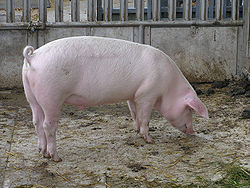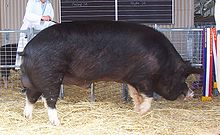Pig
This article needs additional citations for verification. (September 2007) |
This animal-related article may require cleanup to conform to a higher standard of quality. |
| Domestic Pig | |
|---|---|

| |
| A domestic pig on an organic farm in Solothurn, Switzerland | |
Domesticated
| |
| Scientific classification | |
| Kingdom: | |
| Phylum: | |
| Class: | |
| Order: | |
| Family: | |
| Genus: | |
| Species: | |
| Subspecies: | S. s. domestica
|
| Trinomial name | |
| Sus scrofa domestica Linnaeus, 1758
| |
| Synonyms | |
|
| |
The domestic pig (or in some areas hog) is normally given the scientific name Sus scrofa scrofa, though some taxonomists use the term S. domestica, reserving S. scrofa for the wild boar.
Pigs are believed to have been domesticated from wild boar as early as 9000 BC in the Near East and separately in China at about the same time[1]. DNA evidence from sub-fossil remains of teeth and jawbones of Neolithic pigs in Europe shows that the first domestic pigs there had been brought from the Near East. It appears that this stimulated the domestication of European wild boar, effectively forming a third domestication event – the Near Eastern genes later died out in European pigs, and domesticated European pigs were then exported in turn to the ancient Near East[2].
The adaptable nature and omnivorous diet of the wild boar allowed early humans to domesticate it readily. Pigs were mostly used for food, but early civilizations also used the pigs' hides for shields, bones for tools and weapons, and bristles for brushes.[3] Pigs were brought to southeastern North America from Europe by De Soto and other early Spanish explorer. Escaped pigs became feral and were used by Native Americans as food.[4]
Most domestic pigs usually have rather sparse hair covering on their skin, although the woolly coated breeds are known (Mangalitsa pig), and some were popular in the past. [5] Escaped domestic pigs have become feral in many parts of the world (for example, New Zealand) and have caused substantial environmental damage. [6] [7]
Farming

The domestic pig is farmed for its meat, called pork. Other products made from pigs include sausage, bacon, gammon, ham and pork scratchings. The head of a pig can be used to make a preserved jelly called head cheese. Liver, chitterlings, and other offal from pigs are also widely used for food. In some religions, such as Judaism and Islam, there are religious restrictions on the consumption of pork.
In industrialized nations, domestic pigs farming has shifted away from the traditional pig farm to large-scale intensive pig farms where meat can be mass-produced. This has resulted in lower production costs, but more significant animal welfare concerns.

A young female pig who has borne fewer than two litters (or in some usages, no litters) is known as a gilt[8]), a female who has borne more than two litters is a sow, an intact male is a boar, a castrated male is a barrow, and young pigs of both sexes are piglets or shoats (or in areas where the species is called hog, just pigs). Pigs of various ages and types sometimes also have particular names, such as porker or baconer, and the word swine (plural also swine) can be used to refer to all pigs. Female pigs used for reproduction are called breeding sow, while the males are called breeding boar.
Giving birth in pigs is called farrowing, and a pregnant gilt or sow is said to be in pig. A small building in which a pig is kept is called a sty, and a larger one a pig-shed, and a low outdoor shelter for a pig (also for other smaller animals such as chickens or rabbits) is an ark. The feet of pigs are called trotters (they have four hoofed toes, walking mainly on the larger central two). A group of pigs is a herd, or if a smaller group foraging in woodland, a sounder.
In developing nations, and often in developed nations, the domestic pig is raised outdoors in yards or fields. In some cases pigs are allowed to forage in woods, where they are watched by swineherds, the equivalent of shepherds for pigs.
Uses in truffle hunting
The domestic pig is also widely used in France and other countries to search for truffles. This is because the truffle smells similar to the pheromones of the animal.
As pets

Pigs are known to be intelligent animals and have been found to be more trainable than dogs or cats. [9] Asian pot-bellied pigs, a small type of domestic pig, have made popular house pets in the United States beginning in the latter half of the 20th century. Regular domestic farmyard pigs have also been known to be kept indoors, but due to their large size and destructive tendencies, they typically need to be moved into an outdoor pen as they grow older. Most pigs have a fear of being picked up, but will usually calm down once placed back on the floor. Pigs are rarely used as working animals. An exception is the use of truffle pigs – ordinary pigs trained to find truffles.
Breeds of pigs
Pigs are exhibited at agricultural shows, judged either as stud stock compared to the standard features of each breed, or in commercial classes where the animals are judged primarily on their suitability for slaughter to provide premium meat.
| Global pig stock | |
|---|---|
| in 2005 | |
| Number in millions | |
| 1. | 488.8 (50.87%) |
| 2. | 60.4 (6.29%) |
| 3. | 33.2 (3.46%) |
| 4. | 27 (2.81%) |
| 5. | 26.9 (2.8%) |
| 6. | 25.3 (2.63%) |
| 7. | 18 (1.87%) |
| 8. | 15 (1.56%) |
| 9. | 14.7 (1.53%) |
| 10. | 14.6 (1.52%) |
| World total | 960.8 |
| Source: UN Food and Agriculture Organization | |
Rare pig breeds
According to the American Livestock Breeds Conservancy [10], seven breeds of swine in the U.S. are critically rare (having a global population of fewer than 2000). Outside the U.S., the Auckland Island Pig (New Zealand) and woolly-coated grazing pig (Danube area) are known to be critically rare. Rare U.S. breeds include:
See also
- ECODIPTERA
- Exotic pet
- Extensive farming
- Factory farming
- Intensive farming
- Intensive pig farming
- Taboo meat
Notes
- ^ Giuffra E, Kijas JM, Amarger V, Carlborg O, Jeon JT, Andersson L. The origin of the domestic pig: independent domestication and subsequent introgression., April 2000, Template:En icon.
- ^ BBC News, "Pig DNA reveals farming history" 4 September 2007. The report concerns an article in the journal PNAS
- ^ http://www.flossybrush.ca/oral.html Oral Care.
- ^ http://www.cambridge.org/us/books/kiple/hogs.htm II.G.13. - Hogs.
- ^ http://www.malverngazette.co.uk/mostpopular.var.1476623.mostviewed.royal_visit_delights_at_the_three_counties_show.php Royal visit delights at the Three Counties Show.
- ^ http://query.nytimes.com/gst/fullpage.html?res=9E0CEED6103CF93AA15751C1A964958260&sec=&spon=&pagewanted=all Alien Species Threaten Hawaii's Environment.
- ^ http://www.nzetc.org/tm/scholarly/tei-Bio27Tuat02-t1-body-d1.html Introduced Birds and Mammals in New Zealand and Their Effect on the Environment.
- ^ Swine Study Guide from UC Davis
- ^ http://www.rps.psu.edu/probing/pigs.html Are pigs smarter than dogs?
- ^ American Livestock Breeds Conservancy. Retrieved 18 April 2008.
References
- Template:IUCN2006
- The Humane Society of the United States
- Factory Farming Photo Gallery
- Factory Pork Production
